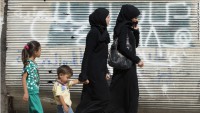
By Jackie Blachman-Forshay
“You’re using YouTube to track rape in Syria? And Twitter?”
I am asked this question on a frequent basis. As a student the Mailman School of Public Health at Columbia University, I take classes to understand the methodological and statistical decisions that are involved in conducting rigorous scientific research. One thing that is not often taught – at least not yet – is how to use social media to do epidemiology. But, when the opportunity presented itself a year ago to begin working with the Women’s Media Center’s Women Under Siege project, I knew it was important to be a part of this initiative.
WMC’s Women Under Siege is using a crowd-sourced map to report sexualized violence related to the Syrian conflict—this is the first time this has ever been done. The work is a collaboration between the Women’s Media Center, Columbia University, the Syrian-American Medical Society, and Syrian activists and journalists. In past conflicts, such as Rwanda or Bosnia, attempts were made to report sexualized violence after the fact. This results in serious under-reporting, however: sexualized violence happens within the context of other war crimes—which may result in the victim’s death, seeking refuge in other countries, or silence due to shame and stigmatization. Tracking sexualized violence in Syria in real time allows us to not only gather stories that may otherwise be lost, but also gives us a better understanding of who is suffering so humanitarian efforts can know where to provide assistance.
Our documentation also has the potential to be used toward evidence gathering if there are ever going to be war crimes trials for atrocities being committed in Syria.
Since launching in March 2012, we have collected, mapped, and analyzed 162 reports of sexualized violence. An article published in The Atlantic last Wednesday lists the most recent statistics from our research: 80 percent of the reports specify female victims, and among those women, 85 percent report being raped. Forty percent of women are raped by multiple attackers, sometimes in cases where the Syrian army works together with shabiha – plainclothes militia forces – to rape the women. Women who survive their attack (almost 18 percent of the female victims in our reports are killed by their attackers or commit suicide after their rape) face additional consequences, including pregnancy (3 percent of reports), chronic physical disease (2 percent), and anxiety or PTSD (10 percent).
We are also showing that sexualized violence is also being perpetrated upon men. Among males in our reports, almost 47 percent report being raped, which is usually used as a form of torture within Syrian detention centers. In this report, a man describes how dozens of government soldiers invaded his home and forced him to watch as they gang-raped his wife and daughters before raping him. “The men were jeering and said, ‘Look at your father.’ They destroyed me,” he said.
As student-activists, we know the power of social media. It enables us to connect, share information, and create change. We are changing the way people are talking about rape in Syria, and we are showing that social media is an important tool in this research. Already, the White House, the U.S. State Department, the U.K. Foreign Office, and the United Nations have all asked to hear more about our research. We’ve seen our map covered in global media, from The Washington Post to CNN International to the BBC.
Getting the message out is a huge step toward showing women and men violated that we are bearing witness to their pain. That they are not forgotten. That the world cares about them. Not only that, but it provides a public accounting of otherwise unimaginable human rights violations.
As one woman from Homs, Syria, states in a video on YouTube after telling the terrible details of her rape, “I might not be the first one nor the last one who was treated in this way.”
Her message is clear:
“Let all the world hear what is happening to us.”
